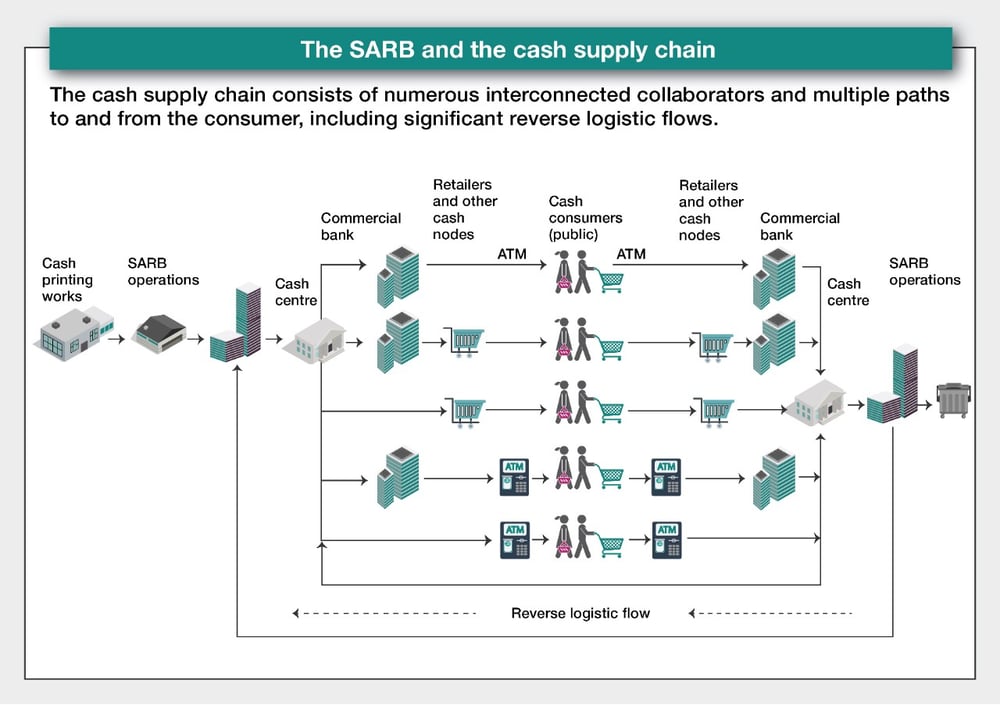Shares, Crypto, Printing of Money & Wealth Sweet Spot: Profits Up To 1000%!
In the intricate world of finance, money is the lifeblood that fuels economies, shapes markets, and drives innovation. Yet, how much do we truly understand the journey of money from its inception to its role in our daily lives?
As part of the #MoneyMarch theme, we'll dive into the processes of money, unravelling the world of cryptocurrencies and discovering the sweet spot where financial success meets consumer demand.
Printing the Money You Have in Your Wallet:
Ever wondered how the crisp bills in your wallet came into existence? Let's take a peek behind the scenes.
In South Africa, for instance, the journey of the Rand from the printing press to your pocket involves meticulous steps.
The South African Reserve Bank (SARB) updates banknotes to maintain currency trust and incorporate technological advancements. The design objectives ensure the currency is secure and recognisably South African.
The SARB, through its subsidiaries - the South African Mint and the South African Bank Note Company - produces coins and banknotes, respectively. These entities manufacture currency based on annual demand forecasts, focusing on technical, quality, and security specifications.
From there, the SARB oversees the large-scale distribution of cash, ensuring public demand is met. The Currency Management Department manages the supply chain, including the distribution and destruction of cash. Banknotes are distributed to commercial banks via cash centres in major cities, facilitating public access through banks and ATMs.
Here's a visual from the South African Reserve Bank that you could find useful:
Each note carries a unique code, making it impossible to conjure money out of thin air. Money in circulation is limited to that which is issued by the reserve bank, circulating from one individual to another, whether through transactions, investments, or business dealings, creating a closed-loop system governed by the principles of supply and demand.
Other financial assets, such as bonds, gold, foreign currencies and other securities , also play an important role in the supply of money. Central banks utilise open market operations to influence the money supply by buying and selling these securitities; when a central bank sells such instruments, it absorbs money from the system. Conversely, when it buys, it injects money into the system, allowing it to expand or contract reserves in the banking system.
Our EasyAcademy covers several topics, including the topic around South African government bonds that are also available on EasyEquities. You can find the free courses below, or at the top right profile menu in your EasyEquities Account.
Understanding the Dynamics of Supply and Demand:
Supply and demand are the twin pillars upon which modern economics stands. Central banks like the SARB meticulously regulate the money supply, adjusting interest rates to influence borrowing and spending behaviour. By carefully calibrating the flow of money, central banks aim to maintain price stability and stimulate economic growth.
The exchange rate, which is the value of one currency in terms of another, fluctuates due to economic factors as well as supply and demand. When demand for a currency is high, its value increases, and vice versa, influenced by factors like interest rates, economic indicators, and geopolitical events.
The US dollar is in high demand due to the stability of the US economy, its status as the primary reserve currency, and its usage in the global market; nearly all commodities, including oil, gold, gas, and coal, which form the basic building block of the global economy, are priced in dollars. Usually, when the dollar depreciates, commodity prices tend to rise, and conversely, commodity prices tend to fall when the US dollar appreciates.
It's not only commodities that we mine, which are believed to always carry and grow in value in the medium to long term; cryptocurrencies have, in recent years, been making waves by generating significant profits for several people.
Crypto Assets:
In the realm of cryptocurrency and assets, the landscape shifts dramatically with Bitcoin, the poster child of the digital age.
While advertisements may tout the possibility of earning millions overnight or weekly from mining Bitcoin and other cryptocurrencies, the reality is far more nuanced. Cryptocurrencies and asset prices, like those of stocks, gold, and other assets, are influenced by supply, demand, news, project utility, technology, and team strength, all shaping their desirability and value.
New coins like Bitcoin need to be mined. Crypto mining is the process of validating transactions on a blockchain network and adding them to the public ledger, known as the blockchain, while also creating new units of the cryptocurrency as a reward for doing so. Miners use powerful computers to solve complex mathematical puzzles that validate transactions and secure the network. This process requires significant computational power and energy consumption.
The supply dynamics of crypto assets vary: Bitcoin has a fixed supply, and Solana is a proof of-stake currency and can't be mined, with each having its unique monetary policy.
And while these markets (crypto, commodities, and other financial instruments, e.g., shares) may at times present great returns for investors, this is not money created out of thin air - so what's the wealth sweet spot?
Finding the Wealth Sweet Spot:
Amidst the ebb and flow of markets, savvy investors seek the sweet spot where opportunity meets demand. Whether it's investing in a beloved company, the most-used but scarce commodity, or backing a burgeoning cryptocurrency, success hinges on identifying trends, anticipating consumer preferences, and being patient.
Think of this: investing in a company with a product or service that resonates with consumers can yield both capital gains and dividend payouts, or a mining company spending less to mine a specific commodity that has seen its price surge over a certain period as a result of policy changes.
Similarly, if a cryptocurrency and asset gains traction as a viable means of exchange or store of value and use for the broader community, investors stand to reap the rewards of capital appreciation as more investors buy into it.
Here are a few examples; looking at the 12-month performance as of writing, we observe mining companies, crypto assets, artificial intelligence (AI), and essential components such as graphics processing units (GPUs), as well as defence and nuclear technology.
- Bitcoin: A cryptocurrency, a decentralised digital currency not backed by any government or central bank (+131% growth).
- Rolls-Royce Holdings PLC: A British multinational engineering and defense aerospace company involved in designing and manufacturing engines for aviation, marine systems, and power generation systems, as well as nuclear reactors (+181% growth).
- 4Sight Holdings Limited: A multinational, diversified technology group involved in Fourth Industrial Revolution (4IR) technologies, which include AI, big data, cloud computing, and the Internet of Things (IoT) (+207% growth).
- NVIDIA Corp: An American multinational technology company involved in developing graphics processing units (GPUs) for the gaming and professional markets and crucial for AI (+245% growth).
- Solana: A high-performance blockchain platform known for its speed and scalability (+769% growth).
- Azure Minerals Ltd: An Australian lithium and nickel exploration and development company focused on securing and developing lithium deposits for the battery market (+1170% growth).
The past performance does not indicate future performance nor guarantee any future profits. It’s important to take into account the fact that high prices, as well as the commoditisation of technology, tend to lead to lower profitability in the long term, thus encouraging more innovation and diversification of assets.
Conclusion
In the world of finance, the balance of supply and demand aligned with consumer needs and wants, market/policy trends, and investor sentiment shapes everything from the value of currencies to the potential of cryptocurrencies and beyond. By understanding the intricate mechanisms that govern our monetary system and seizing upon the sweet spot of money, investors could embark on a path toward prosperity and, potentially, financial stability.
By staying attuned to these dynamics and exercising prudent judgment, investors may be able to confidently navigate the ever-evolving landscape of finance.
Any opinions, news, research, reports, analyses, prices, or other information contained within this research is provided by an employee of EasyEquities an authorised FSP (FSP no 22588) as general market commentary and does not constitute investment advice for the purposes of the Financial Advisory and Intermediary Services Act, 2002. First World Trader (Pty) Ltd t/a EasyEquities (“EasyEquities”) does not warrant the correctness, accuracy, timeliness, reliability or completeness of any information (i) contained within this research and (ii) received from third party data providers. You must rely solely upon your own judgment in all aspects of your investment and/or trading decisions and all investments and/or trades are made at your own risk. EasyEquities (including any of their employees) will not accept any liability for any direct or indirect loss or damage, including without limitation, any loss of profit, which may arise directly or indirectly from use of or reliance on the market commentary. The content contained within is subject to change at any time without notice.
Any opinions, news, research, reports, analyses, prices, or other information contained within this research is provided by an employee of EasyEquities an authorised FSP (FSP no 22588) as general market commentary and does not constitute investment advice for the purposes of the Financial Advisory and Intermediary Services Act, 2002. First World Trader (Pty) Ltd t/a EasyEquities (“EasyEquities”) does not warrant the correctness, accuracy, timeliness, reliability or completeness of any information (i) contained within this research and (ii) received from third party data providers. You must rely solely upon your own judgment in all aspects of your investment and/or trading decisions and all investments and/or trades are made at your own risk. EasyEquities (including any of their employees) will not accept any liability for any direct or indirect loss or damage, including without limitation, any loss of profit, which may arise directly or indirectly from use of or reliance on the market commentary. The content contained within is subject to change at any time without notice.
Subscribe to our Blog
Search all articles
Posts by topic
- Market News & Events
- Easy Community
- Education
- Dividends Update
- Exchange Traded Funds (ETFs)
- Managed Bundles
- Property Investing
- USD Wallet
- Retirement Annuity (RA)
- Cryptocurrency
- Tax Free Savings Account (TFSA)
- International Investing
- Unit Trusts
- New to Investing
- Artificial Intelligence
- EasyProtect
- Shares
- EasyCredit
- Government Bonds
- New Listings
Let Us Help You, Help Yourself
From how-to’s to whos-whos you’ll find a bunch of interesting and helpful stuff in our collection of videos. Our knowledge base is jam packed with answers to all the questions you can think of.






